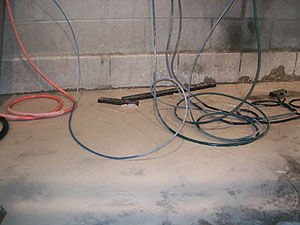
Slab organization is one of the most important aspects in fabrication shop safety - no matter what the size of the space. One of the first steps to achieving this is to throw away material that you have been keeping for years and will probably never use.
Working in a stone fabrication shop is one of the jobs that, by nature, implies that employees will be working under difficult conditions that require complete attention to detail. Stone fabrication is a demanding job that involves heavy equipment, slab/material handling, electricity, compressed air, work in high or confined spaces and the use of blades, grinders and chemicals. Moreover, the environment may include dust, noise and wet conditions.
Far too often, employees are not aware of some of the conditions that are safety risks to employees and visitors. Often, this happens because “we never have had an accident.” During the eight-hour workday, shop employees are generally thinking about the kitchen or vanity they need to finish and not safety in the workplace.

Here, we see the water channels for the recycling
system lacking a cover, which creates a bad falling risk.
We should see our stone fabrication shop with different eyes, under another perspective - using critical thinking and trying to find potential risks. In our hands are many decisions that could be the difference.
We know the consequences that can result from an accident offer - not only a financial loss, but also emotional impact to families. Most industrial accidents are preventable and happen because of the repetition of unsafe acts or prolonged “unsafe conditions.” Simply stated, an “unsafe act” is grinding without goggles, while continually working on a muddy/wet floor is an example of “unsafe conditions.” Some accidents are extraordinary, under circumstances out of the common, but most of them are clearly preventable.

In some stone fabrication shops, the floor is always
muddy and wet. The water used during the fabrication process should always run
to channels.
With such a broad range of machinery involved in the fabrication process - bridge saws, cranes, vacuum lifters, routers, edge profile machines, water pumps, air compressors, electric/pneumatic tools, CNC stoneworking centers and dust collectors - it is the responsibility of the employer to designate someone to ensure that this equipment is in the best condition in terms of safety and operability. They also need to make sure that the safety devices for each machine have not been removed or disabled to make their operation easier for the user. Equipment manufacturers design machinery with the safety system as a priority, and shop mangers/owners are responsible to ensure that these systems are not bypassed.

Although cleanliness should also be a priority in
stone fabrication shops, it is often disregarded as employees focus solely on
production. By establishing boundaries for different “responsibility areas” of
the shop - and clearly marking them on the floor - it becomes the
responsibility of each employee to keep their assigned area in the best
possible condition.
Safety implies education. It is a culture that should be a priority. We should ask our people in the shop about safety, and try to identify the risks. Some examples of questions to ask are:
• Do we know if safety systems such as fire extinguishers or eyewash stations are in good condition?
• Are they ready to use?
• Does everybody know how to use them?
• Does the shop have safety signage?
• Are we having safety meetings?
• Are machine operators using personal protection equipment, including steel toe boots?
• Are they actually wearing their eye/ear protection at all times?

Everyone - including owners, managers, technicians, sales team and clerical employees - needs to share in the responsibility for safety. Unfortunately, too many times, this isn’t addressed until there is an accident. The best firefighter isn’t the one who extinguishes the most fires; rather, the one who achieves prevention.
By stressing organization and cleanliness in the shop, a shop manager/owner is better able to detect the possible risks. Some conditions are very difficult to change (lack of space, old equipment, etc.), but they can still be addressed. Surprisingly, some of the simple items in the shop - such as electrical cords - are often in very bad condition.
In terms of maintaining the shop itself, slab organization is very important - no matter what the size of the space. One of the first steps to achieving this is to throw away material that you have been keeping for years and will probably never use.
The second step is to completely clean the floor and to create “responsibility areas” according to different sections - workstations, bridge saw 1, bridge saw 2, final revision, etc. The boundaries for these areas should be clearly marked on the floor, and you should also clearly demark the fork-lift route at the same time. Once this is achieved, it becomes the responsibility of each employee to keep their assigned area in the best possible condition.
This not only increases safety, but the result is a shop that you will be proud to show to architects, designers, customers and visitors. If you are selling beauty, you should keep your workplace attractive and offer the proper impression of your business.